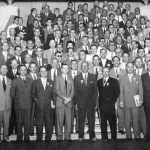
Image Credit: Vitaly Korovin/shutterstock.com
The word rheumatology and its counterpart, rheumatologist, are new to the English language. They didn’t exist 50 years ago. There were a relatively few physicians interested in rheumatologic disease, but not the science of rheumatology. The American College of Rheumatology was founded in 1988.
A few of us still alive, notably, the centenarian Ephraim Engelman, MD, still a practicing rheumatologist at the University of California, San Francisco, can remember the early days. I, too, am among them. I was a founder, in 1949, of the International League Against Rheumatism (ILAR), served as an officer for eight years and knew most of the world’s rheumatologists.
The Pioneers
The leader was the Dutchman, Jan van Breeman, MD, and he was followed by distinguished, mostly northern Europeans and then Americans.
The first use of gold in the treatment of rheumatoid arthritis was by Jacques Forestier, MD, of Aix-les-Bains in France. The Forestier family have continued their original spa, and I remain friendly with them.
Perhaps Stanislaus de Seze, MD, of Paris trained or inspired more French to be interested in rheumatism—people like Jacques Villiaumey, MD, Joel Menkes, MD, and Michel Lequesne, MD—than any other pioneer in the field.
The British picked up the mantle, notably Eric Bywaters, MBBS, who was best known for identifying crush syndrome. He, in London, J.H. Kellgren, MBBS, in Manchester and Allan St. John Dixon, MBBS, in Bath were the British leaders in the field of rheumatology.
In some European countries, there was only a single prominent physician—for example, Leon Michotte, MD, in Belgium, Nanna Svartz, MD, in Stockholm and Eimar Munthe, MD, in Norway.
Soon, the transatlantic crossing was made, and in 1949, the dramatic effect of cortisone was described by Philip Hench, MD, before a few hundred of us at the Annual Meeting of the American Rheumatism Association, the precursor of the ACR. After that, the field of rheumatology interested both research-oriented and practice-oriented doctors.
The great leader Joseph Bunim, MD, of the N.Y.U. rheumatic disease group was well known in Brooklyn as a cardiologist.
The Tools
This was at a time before modern scientific tools had been invented. In my research lab, we barely had an ultra-centrifuge. Thus, most studies were disease oriented. It was common knowledge that, because the body could not destroy itself, there was no such thing as true autoimmunity. It took the development of the latex-fixation test by my fellow, Jacques Singer, MD, and myself to unequivocally show that an antibody, rheumatoid factor, could also be an antigen.
In the 60 years that followed, we have gone from patients to tissues to cells and now to genetic precursors. This basic research, done by very talented investigators, depends heavily on the existence of modern machinery of detection.
The earliest scientific rheumatologists used little but their wits, but they knew what even the most basic researcher today should keep in mind: The care of the patient is what it’s all about.
Dr. Engleman and I knew all the rheumatic disease specialists mentioned earlier, and they had one thing in common: They were all extremely nice, considerate and caring people. The genetics of rheumatology are strong, and the field continues, perhaps on a self-selected basis, to attract that kind of person.
My wife, Lucille, who also knew the earlier, as well as the current, rheumatologists, claims that we are the nicest physicians in the world. Needless to say, I agree with her.
 Among his many distinctions, Charles M. Plotz, MD, MedScD, MACR, is an ACR Gold Medal recipient and holds ACR Master distinction.
Among his many distinctions, Charles M. Plotz, MD, MedScD, MACR, is an ACR Gold Medal recipient and holds ACR Master distinction.
Listen to Dr. Plotz talk about the history of rheumatology in an interview recorded for the ACR’s 75th anniversary.

